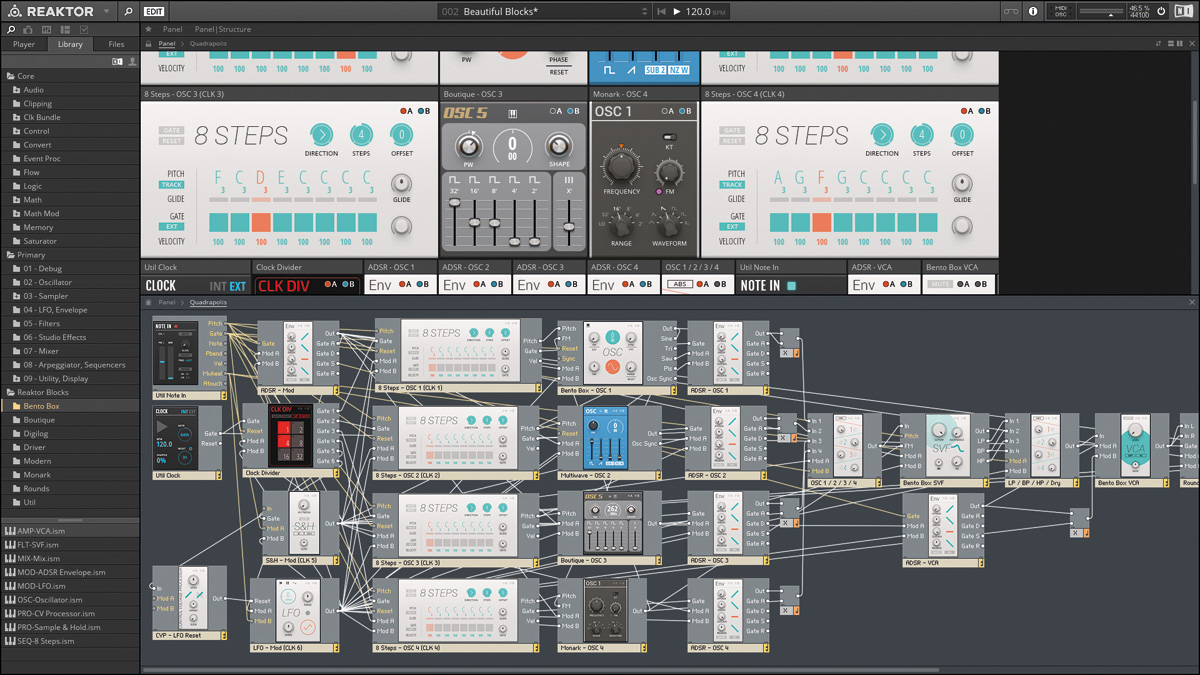MusicRadar Verdict
Version 6 of Reaktor finally realises the series' potential as a practical way to make your own instruments and effects.
Pros
- +
State-of-the-art analogue sounds. The most accessible Reaktor yet. Lots of Blocks to play with. Eurorack compatibility. Outstanding value.
Cons
- -
Predictably high CPU usage Blocks are essentially monophonic.
MusicRadar's got your back
For the uninitiated, Reaktor is a modular audio generation and processing environment with a graphical interface that can be run standalone or as an instrument or effect plugin (VST/AU/AAX).
You can use it to make everything from basic effects and synths to full-on sequencers and grooveboxes.
Traditionally, Reaktor's programming is mostly done at the Primary level, which involves connecting basic modules such as oscillators, filters, delays and mathematical functions to build devices.
Things can get complicated very quickly at the module level, so groups of modules can be bundled into macros, which are then wired together. The complete devices created with modules and macros are saved as Instruments, and multiple Instruments can be racked together to form Ensembles, which is where Reaktor's structural hierarchy tops out.
Block head
Reaktor 5's Core enhancement gave users the ability to edit modules and even build them from scratch - the feature hardcore users keen to make their own individual-sounding oscillators and filters had been waiting for.
The main thing that Reaktor 6 adds to the mix is the modular hardware-like Blocks. These aren't a new hierarchy strata like Core was; rather, they're an Instrument specification - a sort of equivalent of Doepfer's A-100 (more commonly known as Eurorack) hardware spec.
"The main thing that Reaktor 6 adds to the mix is the modular hardware-like Blocks."
NI certainly hasn't gone out of its way to make it clear what Blocks actually are, nor that they're only capable of delivering monophonic results thanks to Reaktor's current inability to send polyphonic information between Instruments. Perhaps unsurprisingly, their focus has been on explaining how Blocks make Reaktor 6 akin to having an enormous modular analogue synth in your laptop - more on that later.
Want all the hottest music and gear news, reviews, deals, features and more, direct to your inbox? Sign up here.
Virtual insanity
If you're familiar with Reaktor, getting to grips with Blocks isn't too tricky. They work just like regular instruments, patched up in Reaktor's Structure view just like everything else in the software.
It feels like NI has missed a trick in terms of potentially making Reaktor more accessible to casual synthesists, though - the addition of virtual cables in the Panel view (where the final Instrument interface is displayed) would have made everything much more immediate and user-friendly.
"Out of the box, you get 30 prefabricated Blocks divided into eight folders."
While new users will likely find the learning curve steep (there's no walkthrough in the Blocks manual, although NI's well-hidden Reaktor Community Learning Resources page has some helpful videos), it's easy enough to start making your own Instruments once you've got the hang of patching Blocks together in the Structure view.
Part of the Blocks specification is that they use audio rather than control signals for all input and output, giving total freedom when it comes to signal routing between them, much like u-he's ACE and Bazille synths.
What's more, with a CV-capable interface (such as Expert Sleepers' ES-6 or MOTU's 828 MkII), it's even possible to use Reaktor in conjunction with your hardware Eurorack system! Combining hardware and software modular systems like this will be worth the price of admission alone for modular enthusiasts - but what's in it for the rest of us?
Glory box
Out of the box, you get 30 prefabricated Blocks divided into eight folders. The first of these folders is Bento Box, which features nine general-purpose components: Osc, SVF, VCA, Mix, Env, LFO, S&H, 8 Steps and CVP.
These are all self-explanatory apart from the Control Voltage Processor, which is a signal shaping tool with Level, Offset and Slew controls, plus Linear/ Exponential and Rectification/Clipping shaping settings - perfect for making modulators more expressive and introducing richer harmonics to voiced signals.
Some of the other folders feature specific elements culled from NI's catalogue: specifically, the filter, envelope and oscillator from their Monark Minimoog emulation, the delay and reverb from Rounds, and the awesome Driver distortion/filter.
The remaining folders are Boutique (two oscillators and a filter based on unspecified classic synth hardware), Modern (comb and smooth low-pass filters), Digilog (a couple of sequencing tools), and Util (eight utilities - mixing, metering and CV processing tools).
The various oscillators and filters sound utterly fantastic, and if you're after analogue-style sounds in your DAW, Reaktor 6 is among the best - very possibly the best - we've heard to date, with unmatchable flexibility. What's more, the supplied Blocks (plus nine ensembles fashioned from them) are just the tip of the iceberg, as NI provides templates for creating your own Blocks, which can be shared in the Reaktor User Library.
The potential here is staggering, and we can't wait to see what the Reaktor community will come up with.
Reaktor 6 is a phenomenal update that improves on NI's already amazing softwarein practically every area, from the Table Framework-enhanced fundamentals to the re-organised library, smart visuals, and, of course, the incredibly exciting Blocks.
Back in our Reaktor 5 review, we noted that its £380 RRP could intimidate the newcomer, but at the ridiculously reasonable 2015 price of £169, Reaktor 6 is a must-buy for any self-respecting computer musician who's able to negotiate a bit of a learning curve.
Computer Music magazine is the world’s best selling publication dedicated solely to making great music with your Mac or PC computer. Each issue it brings its lucky readers the best in cutting-edge tutorials, need-to-know, expert software reviews and even all the tools you actually need to make great music today, courtesy of our legendary CM Plugin Suite.

